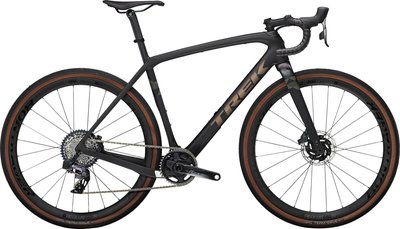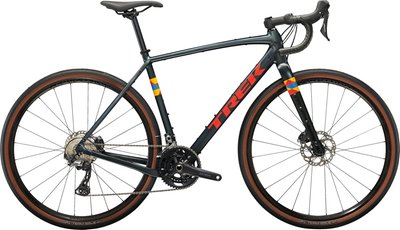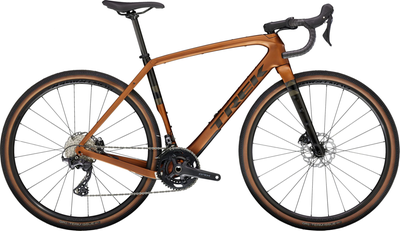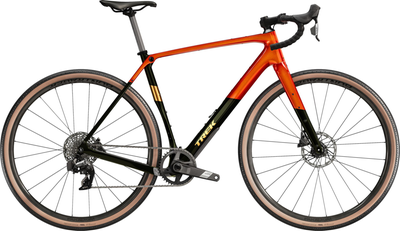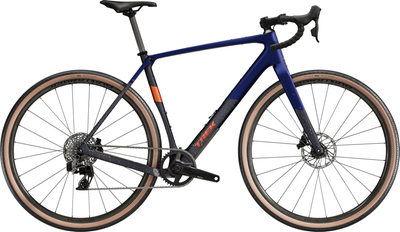Trek Checkpoint
5 Results
Trek Checkpoint: Your Go-To Adventure Bike for Gravel Riding
Are you looking for a versatile, reliable, and high-performance bike that can handle gravel, paved roads, and everything in between? Let me introduce you to the Trek Checkpoint - a gravel bike that has become a favorite for riders of all levels. Whether you're planning a weekend ride on dusty trails, commuting to work, or thinking about participating in a long gravel race, the Trek Checkpoint is designed to meet your needs. With a range of models like the Trek Checkpoint ALR 5, Trek Checkpoint SL5, and Trek Checkpoint SL6, there's a version of this bike for everyone, whether you're a beginner or a seasoned cyclist.
In this guide, I'll take you through everything you need to know about the Trek Checkpoint, its key features, and what makes it stand out in the gravel bike market. By the end, you'll have a clear idea of which model is right for you and why the Trek Checkpoint deserves a spot in your garage.
What Makes the Trek Checkpoint Special?
The Trek Checkpoint is designed for gravel riding, a growing trend in the cycling world. Gravel riding combines the excitement of road cycling with the unpredictability of off-road terrain, which requires a bike that's both rugged and comfortable. The Trek Checkpoint excels in this area, thanks to its endurance-focused geometry and high-quality materials. It’s perfect for long rides where comfort is key, but it doesn’t sacrifice speed or handling.
One of the first things you'll notice about the Trek Checkpoint is its lightweight frame. Models like the Trek Checkpoint SL5 and Trek Checkpoint SL6 use a 500 Series OCLV Carbon frame, which makes them light yet incredibly strong. Meanwhile, the Trek Checkpoint ALR 5 and Trek Checkpoint AL3 come with an aluminum frame, making them more budget-friendly without compromising on durability or performance.
Carbon vs. Aluminum: Which Trek Checkpoint Is Right for You?
When choosing between the different Trek Checkpoint models, the most important decision is whether you prefer a carbon or aluminum frame. The Trek Checkpoint SL5 and Trek Checkpoint SL6 are made from carbon, which provides a smoother ride and better vibration damping. This makes these models ideal for long-distance rides over rough terrain. The carbon frame also helps to reduce fatigue, allowing you to push harder for longer.
On the other hand, the Trek Checkpoint ALR 5 and Trek Checkpoint AL3 feature aluminum frames, which are slightly heavier but still offer excellent performance. These models are perfect if you're new to gravel riding or looking for a more affordable option. The aluminum models are tough, durable, and still light enough to be competitive in races or long rides.
Versatility: A Bike for Every Occasion
One of the biggest selling points of the Trek Checkpoint is its versatility. It's not just a gravel bike—it's a do-it-all machine. You can easily mount racks, fenders, and even a bikepacking setup if you're into adventure touring. This makes it a great choice for cyclists who want a bike that can handle both daily commutes and weekend adventures.
The bike also features wide tire clearance, allowing you to run tires up to 45mm wide. This means you can customize your ride based on the terrain you're tackling. Want more grip and control on loose gravel? Throw on some wider tires. Looking to go fast on the road? Opt for something a little narrower.All Trek Checkpoint models also come equipped with multiple bottle cage mounts, so you're set for long rides where hydration is key. Plus, with hidden fender mounts, you can quickly transform your bike into an all-weather commuter.
What’s the Difference Between the Trek Checkpoint SL5, SL6, ALR 5, and AL3?
If you're wondering about the specific differences between the various Trek Checkpoint models, here’s a quick breakdown:
Trek Checkpoint SL5: The SL5 is a fantastic mid-range carbon gravel bike that combines comfort, performance, and value. It comes with Shimano 105 components and hydraulic disc brakes for reliable stopping power. This model is great for riders who want the benefits of a carbon frame without breaking the bank.
Trek Checkpoint SL6: The SL6 takes things up a notch with an upgraded groupset (Shimano GRX) and even better components. It's perfect for riders who want top-of-the-line performance, especially for racing or long-distance endurance events.
Trek Checkpoint ALR 5: The ALR 5 is the best aluminum option in the lineup. It shares a lot of the same features as the carbon models but at a lower price point. The ALR 5 is ideal if you're looking for a high-performance bike that won’t hurt your wallet too much.
Trek Checkpoint AL3: The AL3 is the entry-level model in the Checkpoint range. It’s more affordable but still offers a great ride quality, making it perfect for riders who are just getting into gravel biking.
Components that Enhance Performance
No matter which model you choose, the Trek Checkpoint is packed with high-quality components that enhance your ride. For starters, all models come with disc brakes, which offer superior stopping power in all weather conditions. This is especially important when you're flying down a steep gravel descent or navigating through muddy trails.The wide range of gearing options also makes the Checkpoint an excellent choice for riders who plan on tackling varied terrain. Whether you're grinding up a steep hill or cruising on flat gravel roads, the bike’s drivetrain is designed to give you the right amount of power and control.
Another great feature is the IsoSpeed decoupler (available on the SL models), which smooths out rough terrain by allowing the seat tube to move independently from the rest of the frame. This reduces road chatter and makes your ride more comfortable without sacrificing speed or efficiency.
Is the Trek Checkpoint Worth It?
In short: absolutely. The Trek Checkpoint offers an incredible mix of performance, versatility, and value. Whether you're new to gravel biking or looking for a high-end model to dominate races, there's a Checkpoint for you.The Trek Checkpoint SL5 is perfect for those who want a lightweight carbon frame without going all-in on price, while the Trek Checkpoint SL6 is ideal for riders who demand the very best. If you're more budget-conscious but still want a bike that can perform, the Trek Checkpoint ALR 5 and Trek Checkpoint AL3 offer solid options without sacrificing too much in terms of quality.
Final Thoughts: Why the Trek Checkpoint Is Your Ultimate Adventure Bike
The Trek Checkpoint is a bike designed for adventure. Whether you're taking on your first gravel race or just exploring the backroads on the weekend, this bike can handle it all. With its customizable setup, wide tire clearance, and durable frame options, it's a versatile choice for any rider. Plus, with models like the Trek Checkpoint SL5, Trek Checkpoint SL6, Trek Checkpoint ALR 5, and Trek Checkpoint AL3, there's truly something for everyone.
FAQ: Trek Checkpoint
1. What is the difference between the Trek Checkpoint ALR and SL models?
The main difference is in the frame material. The SL models (like the Trek Checkpoint SL5 and SL6) are made from lightweight carbon, while the ALR models (like the Trek Checkpoint ALR 5 and AL3) use aluminum. Carbon frames offer better vibration damping and a smoother ride, while aluminum frames are more affordable.
2. What is IsoSpeed, and why is it important?
IsoSpeed is a decoupler found on the SL models of the Trek Checkpoint that allows the seat tube to flex independently from the frame. This helps to absorb bumps and vibrations, providing a smoother and more comfortable ride, especially over rough terrain.
3. Can I use the Trek Checkpoint for bikepacking?
Absolutely! The Trek Checkpoint is designed with adventure in mind. It has multiple mounting points for racks, fenders, and bottle cages, making it perfect for bikepacking trips.
4. What is the tire clearance on the Trek Checkpoint?
The Trek Checkpoint can accommodate tires up to 45mm wide, allowing you to customize your ride based on the terrain and conditions you're facing.
5. Is the Trek Checkpoint a good bike for beginners?
Yes, especially the aluminum models like the Trek Checkpoint AL3 and ALR 5. These bikes offer excellent performance at a more affordable price, making them a great choice for riders who are just getting into gravel biking.

